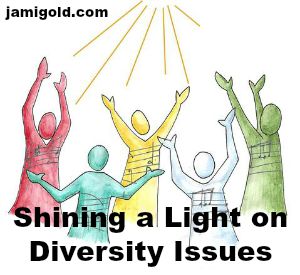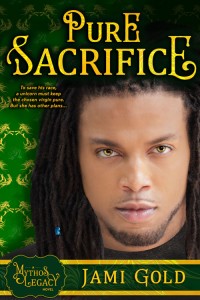I’m gearing up for the release of my second full-length novel, Pure Sacrifice, on August 12th. This book was difficult for me in many ways, mostly because of the revision process, but one frustrating aspect was beyond my control.
I’ve written before about how we shouldn’t assume our characters belong to a straight, white, middle-class default because that’s lazy writing:
“The fastest, easiest way to create more diverse stories is to start with a blank slate. Don’t have a “default” character.”
I never force anything in my stories, and I don’t believe in quotas. Yet my stories contain diverse characters because I take the extra step of asking just one question to avoid the problem of my brain sending me Mr. Generic from Central Casting:
“Whenever a character—from my protagonists to the nameless, just-above-a-spear-carrier minor characters—appears on the page, I stop and listen.
- I first ask myself if this character that popped into my head feels three-dimensional, like they’re real and natural, or does the character feel like a “stock” or “default” character?
(In my talk-to-myself brain, the latter often comes out as me asking, “Hi, welcome to my story. Who are you?” and I get a zombie-like “Uhhh” in response.) - If it’s the latter, I shove them away, and I listen more until I hear a voice that feels real.
- Then I let them tell me who they are. *smile*
Note: There is no wrong answer because there’s no quota.”
Because of that step of not assuming, of waiting until I hear a voice that resonates, I knew my paranormal character for this book wouldn’t be white skinned. Great! Except…
The Ugly Side of Cover Design
The branding for my Mythos Legacy series depicts the paranormal character (whether hero or heroine) on my covers. So the cover of Pure Sacrifice needed to depict Markos, my shapeshifting unicorn hero. The character who is not white skinned.
(Note: He’s not African-American either. He’s a unicorn—and like all those of his race, his humanoid shapeshifted form could “pass” for black on Earth. However, by no means do I claim or label this book to be an interracial romance or anything to do with the black experience. The dichotomy of mythological unicorns being “white and pure” and their humanoid form being darker skinned is just how the character came to me.)
In the traditional publishing world, it wouldn’t be unheard of for the publisher to whitewash the cover and choose a model that “wouldn’t affect sales.” In fact, I’ve heard of several books with whitewashed covers along those lines.
Maybe having a non-white model on the cover does affect sales. Maybe it doesn’t.
(So far, my preorder sales says it doesn’t. Take that publisher assumptions! *smile*)
But one of the benefits of indie publishing is ensuring that our books meet our expectations. And I refused to whitewash this cover.
Diversity Is Needed Everywhere
While I was drafting the story, the visual inspiration for Markos was the actor Jason Momoa, who is known for Stargate: Atlantis, Conan the Barbarian, Game of Thrones, and DC’s new Aquaman.

Um, yeah, dark-ish skin and dreadlocks? There’s no whitewashing that. *smile* (And I feel compelled to ask: Besides, who would want to whitewash him away?)
However, then I ran into another problem: stock photo sites. Searching on “dreadlocks” brought up a bunch of white-skinned hipster types, while most of the dark-skinned models were posed and shot to look like drug users. Yeah, no racist assumptions there. *rolls eyes*
I searched every stock photo site. I asked a few models I’ve befriended this past year if they knew anyone. I even put out a call for a custom shoot that never came together. In short, I spent months upon months looking for an intense, sexy, non-drugged-out appearing, dark-skinned man with dreadlocks.
Nothing…until I searched “dreads” instead of “dreadlocks” on one of the sites. (And boy, is that ever a lesson on the importance of tags for our work.) There, I found one new model. Luckily, that model was perfect. *smile*
The Many Diversity Issues around Us
This problem of non-diverse cover stock is nothing new. Courtney Milan wrote about her struggles with the issue over a year ago.
One of the panels at the just-completed RWA conference poked fun at the limited stock by using one of the few interracial couple shots on the cover of their workshop handout: Celebrating the MOST used stock couple in any one genre!
(The rest of the handout by Alyssa Cole, Lena Hart, K. M. Jackson, and Falguni Kothari is great for sharing some do’s and don’ts for multicultural stories. They also include links to helpful resources, such as diverse stock photo sites. Much appreciation to them for sharing their handout with everyone!)
Sometimes we don’t see the problems around us until we stumble over them or they’re pointed out to us. That’s why it’s so important to listen to marginalized voices. It’s far easier to see what is around us (active racism, etc.) than to see what isn’t (lack of opportunities, etc.).
Yes, we need diverse books. But—as I discovered with this story—we also need diverse cover models and diverse everything else. Plus, there’s a difference between diverse characters and diverse authors.
White authors like myself can research and add diversity to our stories, but in a perfect (or perhaps, fair) world, the voices of diverse authors would be louder when it comes to diversity so they can direct their own stories. Yet too often, that isn’t what happens.
In following the #RWA15 tweets last week, I was horrified to learn how poorly some of my fellow authors are treated within the industry just because of the color of their skin. Many of the tweets about the Diversity in Romance: Why it Matters workshop were captured in a Storify by Alisha Rai, one of the panelists.
Too often, traditional publishers see black romance authors and think their books would appeal only to black women. No matter how mainstream their stories, they’re shunted to the “diverse” imprint in many publishing houses.
As a result, their books are sold on a separate shelf in bookstores and labeled African-American Romance. Panelist Farrah Rochon calls this is the most blatant form of segregation still in existence.
To add insult to injury, those imprints are often priced higher. Gee, not marketed to mainstream readers and priced higher? Yet publishers blame the authors and not themselves for “disappointing” sales. *shakes head*
So What Can We Do?
- We can make sure we’re not lazily defaulting to stock characters. As I’ve said before, “If it takes reading a diverse book from a white-bread author to show people that, yes, they can relate to stories with diverse protagonists, I say bring on the diverse books from any author who wants to take on the challenge.” And as the panelists said in answer to the question, “Who should be writing diverse books?” “Everyone.”
- We can research to ensure we’re not defaulting to stereotypes when we write any kind of character.
- We can ask a member of the appropriate community to check our work for problematic elements (and if they point something out, we should listen).
- We can boost the voices of diverse authors: link to them, retweet them, share their words, etc.
- We can watch out for assumptions about not being able to relate to stories with diverse characters or written by diverse authors. After all, we can all relate to the human experience.
- When we find books we like by diverse authors, we can support them: buy their books, promote their work, etc.
- We can support diverse resources. (For example, I participated in Mosiac Stock‘s Kickstarter several months back.)
Most of all, we want to ensure that we see past any defensiveness caused by guilt, quota assumptions, or political correctness. “Diversity” isn’t a genre, so this isn’t about trying to change our storytelling as writers or our reading habits as readers.
Most stories with diverse characters aren’t (or shouldn’t be) about the diversity issue. Readers simply want a good story, and the “specs” of the characters shouldn’t affect that. As someone who writes shapeshifting unicorn heroes, I should be able to handle characters who aren’t like me. *smile*
Do you write diverse characters? Have you seen areas like the stock photo issue where more diversity would be helpful? Have you run into any problems with including diverse characters? Do you have other suggestions for what we can do to help? Are there books you’ve loved by diverse authors that you want to promote in the comments?


